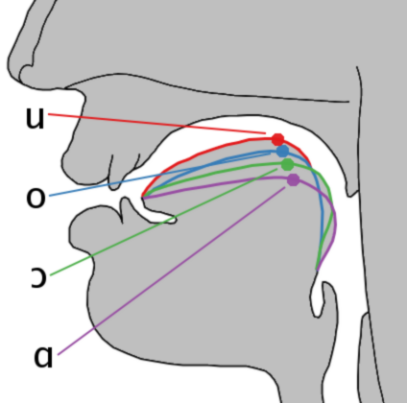
Tongue Positions of
Different Vowels in Phonetics
Am I the only one who thinks that the Italian “u” vowel is extremely important to building a great voice, or have the greatest singers and teachers of all time said the same thing? In this post series, I will discuss some technical things about the “u” vowel, as well as the history of which singers and teachers used it, with exact quotes from the writings of many of them. Then I will ask some questions about how the “u” vowel relates to our modern day vocal training situation. Let’s begin!
The “u” vowel is one of the greatest tools one can use (when paired with the breath) to build great high notes in the voice, and to sing through the register’s break. The “u” vowel is a vowel that favors the head voice, the mechanism that allows the opera voice to function. It is a harder vowel to grow with power. This is what gives it the role of the ultimate head voice vowel. When sung very softly on the breath in the right placement of the voice – something that takes a while to learn – the “u” vowel creates a great voice by making the voice thinner (therefore controllable) and more free. It is a great tool to take out rigidity.
The thing that destroys the “u” vowel’s ability to create a great voice is forced rigidity, in other words, the unrestrained chest voice. The more the chest voice is forced upwards, the more it becomes difficult to summon an “u” vowel tone on the breath. This is because the chest voice blocks the air and forces the upper tones to be wider than they should be. The “u” vowel needs the air and creates thin tones. These methods of training obviously then are opposites. Forcing the chest will destroy your voice, and correctly using the “u” vowel will give you a phenomenal voice.
Being that I cannot teach you to sing well through this post alone (please try to find a great teacher, I listed many in my book A Complete Guide to Opera), I will say one more thing. Almost all singers (especially amateur singers) that I have met today have forced the chest voice upwards. This will create a rigid voice that is either unthrilling, has a break, is forced, or all of the above. One of the first steps to fixing this in the voice is to use the “u” vowel softly -with the breath and the head voice- to take out the forced chest voice, and return the voice to a free and relaxed state where the breath is its only power. Then, the size of the tone is returned to what it should be, a thin throat space that thins as it ascends just like the strings in a piano.
What if I told you that I can give you exact quotes showing that Enrico Caruso, Rosa Ponselle, Lilli Lehmann, Manuel Garcia, Giovanni Sbriglia, Jean De Reske, Alan Lindquest, David Clippinger, and Anthony Frisell -many of the greatest names in opera- all knew the value of the “u” vowel and its ability to build great high notes? That would be pretty incredible wouldn’t it? We’ll talk all about it in part two of this post! See you next time!
The picture of the different tongue positions in the mouth cavity is accredited to this source, https://commons.wikimedia.org/wiki/File:Cardinal_vowel_tongue_position-back.png


